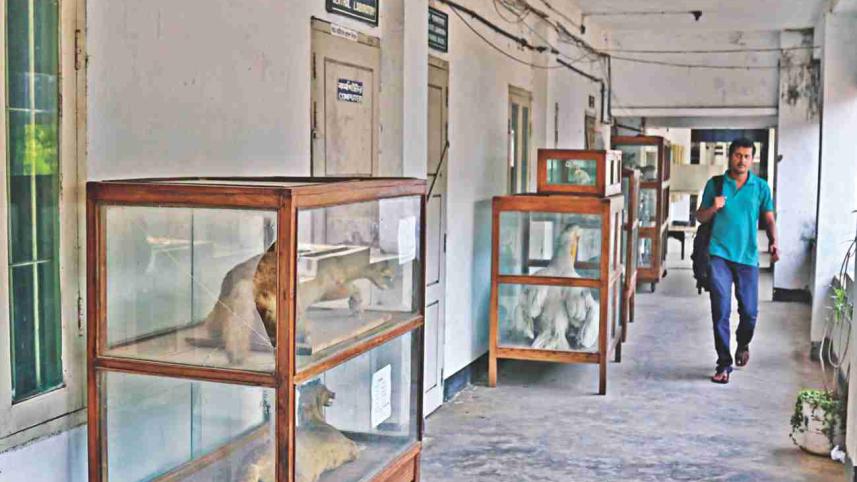CU Zoology Museum wasting away
animal species getting perished, claim students and teachers

There is a room on the fourth floor of the faculty of science building, near the zoology department, on the Chittagong University campus, which is quite shabby and dusty, and at first glance looks like a storeroom with numerous jars and shelves crammed together.
Upon a closer look, the room suddenly becomes filled with broken skeletons and remains of dead animals, birds, reptiles and fish, preserved through taxidermy or in solutions inside big jars.
Many of these samples are either lying or kept on top of the glass-covered wooden shelves.
Curious, if you look around, you will notice a small rectangular signboard on the hallway wall, announcing that this 25 by 25 square feet room is actually a zoology museum.
Due to a lack of space inside the room, a number of glass showcases including one with a skeleton of a cow brought from Poland, another containing a taxidermied jackal and a Maya Horin (barking deer) have been kept in the hallway outside the museum.
Looking at the deer, one may wonder if it had albinism.
“We could not stop bleaching of the species (samples of which were taxidermied) as we cannot control the temperature of the room,” said Assistant Prof Mohammad Abdul Wahed Chowdhury of the zoology department.
Museum section officer Abdus Salam, working in the museum since its opening in 1976, said the museum has about 5,000 preserved samples from 687 different animal species, of which at least 100 are rare.
However, due to improper preservation, lack of space, staff shortage and inadequate fund allocations, the valuable samples of different rare animal species are getting perished, claimed students and teachers of the department.
Visiting the museum, The Daily Star found that at least samples of 100 species were lying on the floor.
Some 150 samples, including the taxidermy of a 15 feet python lay on top of the shelves in the museum, gathering dust and losing its original colour and texture. Another 14 feet taxidermied King Cobra wrapped around a wooden stump was found in a similar condition.
Some skeletons and taxidermied samples of birds and reptiles were broken due to negligence. Also no stickers describing identity of the species were attached on the pots or jars.
Showing a taxidermied pelican bird which was kept in the hallway, Salam said it is the only preserved sample found in museums in the country.
“Only one room has been allocated for the museum, which is inadequate for preserving all the samples properly,” said Salam explaining why some of the samples were kept on the hallway.

"We have sent letters several times to CU authority seeking two more rooms and staff, but we have only received assurance,” he added.
The students also expressed their dissatisfaction over the space crisis.
“Ninety percent of practical classes are held at the museum. But only 10 to 12 students can stand together while others have to remain outside,” said Toukir Ahmed, a third year student of zoology.
The department stopped collecting samples as it has no space for preservation, said Manzoorul Kibria, an associate professor.
Fund crisis is another challenge the museum is facing.
Salam said last year the museum received an allocation of Tk 45,000, which was inadequate. “We need at least Tk 1 lakh every year,” he added.
Prof Wahed, however, said more money is required to change the alcohol in the jars every three to four years for long term preservation.
Talking to The Daily Star, the department's Chairman Prof Gazi Azmat admitted that the museum is riddled with problems. “It (the museum) has the prospect to be a natural history museum as it is located in the Indo-Myanmar biodiversity zone,” he said.
“We are preparing a list of our needs and recommendations for the museum and will contact the VC soon in this regard…all depends on the authority's good will,” he said, adding, ranking of a university in foreign countries depends on these kinds of natural museums.
Contacted, CU Vice Chancellor Prof Iftekhar Uddin Chowdhury denied getting any letter with regards to increasing the allocation. He said he has already visited the museum and will take steps immediately after talking with museum authorities.




 For all latest news, follow The Daily Star's Google News channel.
For all latest news, follow The Daily Star's Google News channel.
Comments